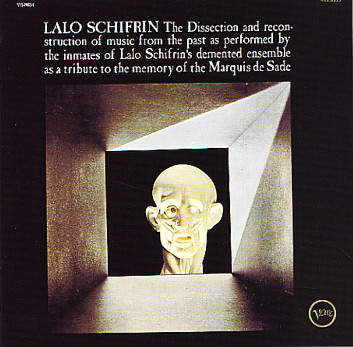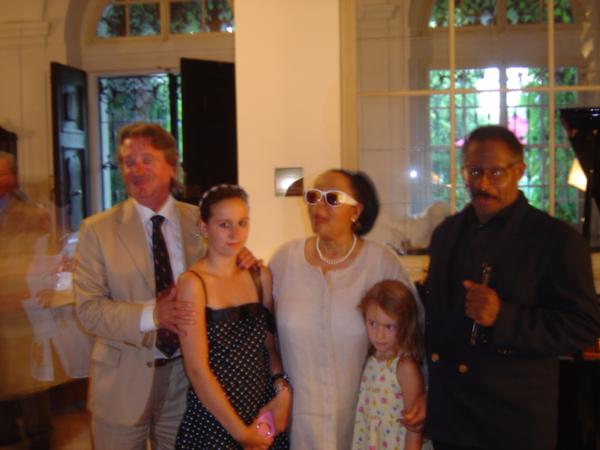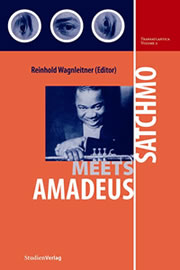“The classical music of globalization”
Impressionistic musings on Satchmo Meets Amadeus
Sometime around Y2K, I found a tasty piece of vinyl at a San Antonio thrift-store for a quarter: The dissection and reconstruction of music from the past as performed by the inmates of Lalo SchifrinÂ’’s demented ensemble as a tribute to the memory of the Marquis de Sade (Verve 1966).

For short: Schifrin/Sade. I found it stuck under my rickety shopping-cart wheel, making the metal hinges swing the rolling basket in circles. This is sort of what the music did to my mind.
When I played this piece at parties, almost no one had a frame of reference for a rollicking mesh of blues, Bach, bebop, and “Bossa Antique” — harpsichord scatting and chamber improv on cello and viola just didnÂ’t seem to catch on.
But to me, it was perfect: An Argentine pianist/bandleader — the guy who penned “Mission Impossible” and dozens more themes — dredging classical baroque notions into a bluesy jazz idiom for a kind of soundtrack for my strolls, years later, into the hills of Salzburg.
Mozart would have sat in on that jam session.
You see, across nation and time and cultural context, jazz persists and continues to inform such experiences of world waltzing. As Salzburg historian Reinhold Wagnleitner puts it in his excellent collection Satchmo Meets Amadeus, jazz is “the classical music of globalization.”
I had the pleasure of meeting Reinhold at a recent Salzburg Global Seminar, and I wanted to share with him my stories of musical admixture, my own head medley produced by Bootsy and amplified by Wagner (maybe with a few beats by DJ Qbert).
The essence of his anthology, based in cross-disciplinary symposia from New Orleans to Salzburg: That Satchmo meets Amadeus every time we recognize the glorious, global connections between classical, pop, and our current mass culture. From the uneasy navigation of their hometown limitations, to the enshrining of each with an invisible TRADEMARK insignia, Pops and Moze created music that really moved, from Salzburg to Vienna, from New Orleans to Chicago to New York, and their tunes (properly received) turned the idea of classical versus pop, of high versus low culture, right on its powdered-wig head.
But more than that, Satchmo Meets Amadeus explodes the dichotomy between controlled, complex, classical execution versus naïve, “native” jazz genius. (In the shadows, observe the tired, hung-out-to-dry notion that jazz was purely African in provenance, later stolen by white people for someone else’s profit.)
Consider the Jews expelled from Europe, Austria included, who spread the tidings of classical music and helped build an industry of American production and distribution, recognizing genius where others saw only “race records.” Consider the Sicilians in New Orleans who taught voice, instrumentation, and arrangement to black people. Consider New Orleans as the biggest opera city in 19th century USA, mounting Mozart for Sidney Bechet, Buddy Bolden, and of course Satchel Mouth, among others.
Contrasting the catch-all put-down of “world music” as currently conceived, Satchmo Meets Amadeus gives true meaning to jazz as the first authentic world music, a sound forged in the uniquely spiced pot of New Orleans gumbo that included Creoles, Euros, Indios, and Africans of every diasporic shade and savor. From these origins, jazz went up the Mississippi to the Northern industrial corridor, on to New York, and out to the rest of the world, recognized finally and especially through the traumas of World War as the true sound of liberation.
The operative metaphor, here, is apt and American: The shot-gun wedding. Satchmo Meets Amadeus is a sort of nuptial presided over with a rifle. Like the deep Southern, Scots-Irish/Appalachian blood-feud brought to a boil by a bastard child and a marriage pressed at the end of a gun barrel, this book brings together global players divided only by historical amnesia but now thrown into conversation by the cataclysms of the 20th century, immanently unpacked in the idiom of globalization.
Highlights include Penny von Eschen’s re-hash of Satchmo Blows up the World (Harvard UP 2004), here sliced down to a meditation on “The Real Ambassadors” during the Cold War, touching on Louis Armstrong’s partly-Pepsi-sponsored tour of Africa in 1960-61, capturing the glaring contradiction of Jim Crow America touting black musicians to fight Cold War race perceptions. This piece carries over into essays about both Nazi contradictions with respect to jazz and the contradictory uses of Satchmo/Amadeus in pop/tourism.
Deeper still, historic pieces dig into the related histories of the Habsburg Monarchy, Salzburg, and New Orleans, within the context of colonial bartering and power-positioning. While recognizing the place of jazz as “the American high modernist contribution to world culture,” other pieces — such as “New Orleans: An American Pompeii?,” by Lawrence N. Powell — struggle to place Satchmo/Amadeus at the center of our current concepts of globalization. Given the rate of global change, will New Orleans merely be the first of various cities leveled and lost to climate shifts? And what will we have learned, really, from Satchmo/Amadeus, beyond tourism soundtracks, if their global import becomes sunken lost treasure?
In addition to the big questions, I take away from Satchmo Meets Amadeus a personal connection with Reinhold Wagnleitner at the Salzburg Global Seminar this July 2007. I enjoyed his personal narratives of trying to open up the Salzburg scene, to get past classical stagnation with the energy of jazz. His stories about musicians, tunes, and concerts remind me of my own love for such cities as San Antonio, for its unique contributions to American and global cultures.
(See, also, period pictures of Reinhold in his Â’70s jazz/rock combo Pentameter, for which he played bass and injected new music into the Salzburg youth scene, documented in Satchmo….)
Behind today’s trademarks and copyrights, you can still find the spark of musical revolution and a true global avant-garde, now on MP3 blogs and electronic platforms of digital convergence. WhatÂ’s the next variation, Mozart? WhatÂ’s the time signature and key, Satch?
Perhaps a sequel? A reprise, titled FLACO MEETS FALCO, A “Texe-Mexe” Odyssey featuring Mozart-as-Mestizo on the Frontiers of New Sanzburgtonio? Or Wolfie’s Beautiful Big Enchilada, maybe Sir Douglas Sahm as Hill-Country Jedermann, or From Yodel to Grito: Alps Meet Hicks in the Trans-Atlantic Tradition of Country Yelping…etc., etc., etc., usw, &c.

[Reinhold Wagnleitner, with musicians Valerie Capers and John Robinson, plus daughters Anna and Ella, after the Salzburg Seminar International Studies Program 20 Jazz Concert and Banquet…]
« Salzburg Global Seminar / International Studies Program 20 (July 2007) Hard-Boiled Hot Fuzz »



